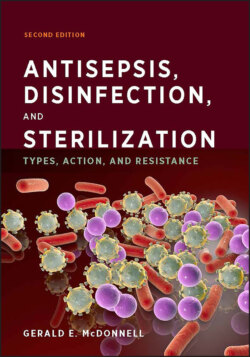Читать книгу Antisepsis, Disinfection, and Sterilization - Gerald E. McDonnell - Страница 40
1.4.8 The Importance of Cleaning
ОглавлениеCleaning is the removal of contamination from an item to the extent necessary for its further processing and its intended subsequent use. In many applications, it is important to ensure the removal of residues following the use of a reusable surface, for example, to prevent cross-contamination between pharmaceutical manufacturing batches, to reduce the level of bioburden on the surface, and particularly, to ensure that a subsequent biocidal process can be effective. Various surfaces require routine cleaning, including manufacturing vessels, equipment, or areas; food-handling surfaces; and reusable medical, veterinary, and dental devices. The presence of various organic (including lipids, proteins, and carbohydrates) and/or inorganic (including various heavy metals like calcium and iron) soils on these surfaces can often dramatically interfere with the activity of a biocide.
Cleaning is generally achieved by a combination of physical and chemical processes. Physical effects include simple immersion, manual cleaning (brushing and wiping), and automated cleaning. Automated cleaning includes the use of washers (or washer-disinfectors [Fig, 1.27]) and clean-in-place systems. Clean-in-place systems are integral to manufacturing equipment (such as reaction vessels), which can be automatically cleaned without disassembly. Automated washing machines allow the placement of items into the washing chamber for exposure to a cleaning process. They can be used for washing only or as washer-disinfectors, which are used to clean and disinfect (using heat and/or chemicals) devices and other articles. They can consist of single- or multiple-chamber washers and provide physical cleaning by agitation, directed flow, spraying, and ultrasonics (where the items are immersed and exposed to sound waves that aid in the physical removal of soil).
FIGURE 1.27 Examples of single (left)- and multiple (right)-chamber washer and washerdisinfector machines. Washer-disinfectors can come in a variety of shapes and sizes, depending on their required uses.
Chemical cleaning is achieved using various types of cleaning chemistries (Fig. 1.28). Similar to formulation of biocides (see section 1.4.6), cleaning formulations can contain a variety of components that aid in the chemical removal of soils from a surface (Table 1.28). Cleaning chemistries can be classified into various types, including enzymatics and nonenzymatics. Enzymatic formulations contain active enzymes that degrade various organic-soil components over time, including lipases (lipids and oils), proteases (proteins), and amylases (starch and other carbohydrates). Nonenzymatic formulations can be further subclassified into neutral, acidic, and alkaline cleaning formulations. Acid cleaners are particularly used for the removal of scale and mineral deposits, while alkaline cleaners are particularly effective at removing and degrading protein-based soils. Neutral cleaners, depending on their formulations, usually have the widest compatibility with various types of surfaces. In some applications, simpler cleaning chemistries are employed, including alcohol wipes and high-quality water (such as water for injection [see section 5.2]).
FIGURE 1.28 Various types of cleaning chemical formulations.
The choice of physical and chemical cleaning processes depends on the types and levels of soils that are present on a surface. The overall efficacy and efficiency of these processes can be optimized for a given application by consideration of the cleaning contact time, chemical concentration, temperature, and efficiencies of physical effects.
